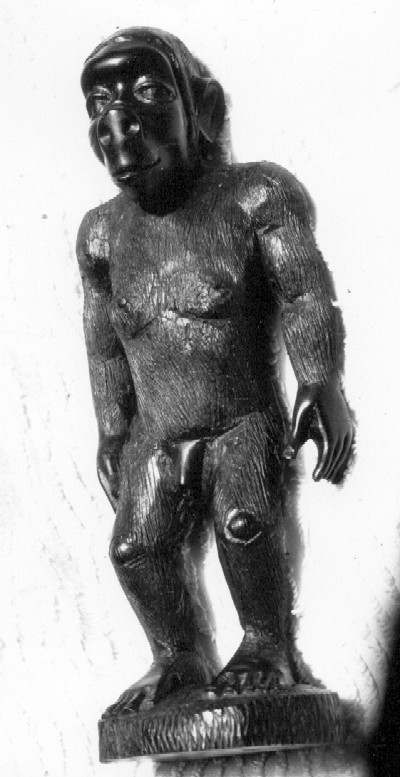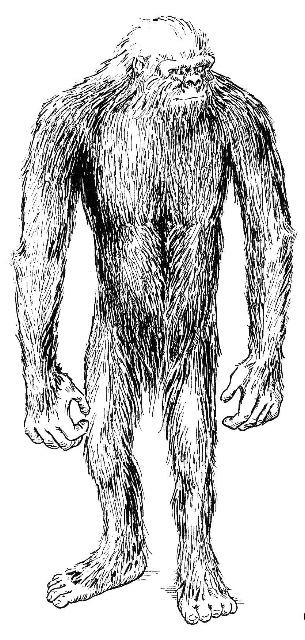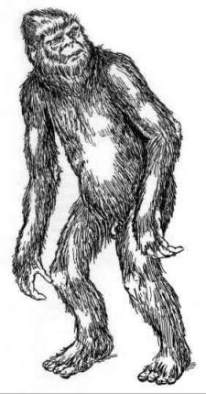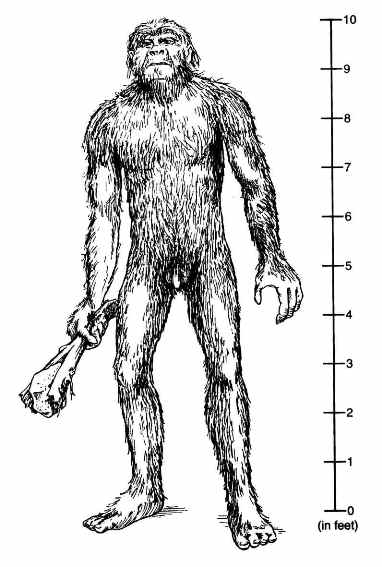Cultural Hominology
Posted by: Loren Coleman on April 24th, 2009
If anthropology has a branch called cultural or social anthropology, perhaps the study of hominoids, hominology, has a section that should be called “cultural hominology”?
It is always a good exercise to step back from your own work, and view it through another’s eyes.
Here is an intellectual contribution from T. Peter Park:
Cultural vs Cultureless Hairy Hominoids
Loren Coleman and Patrick Huyghe distinguish between nine main classes of mystery primates and anomalous hominids in The Field Guide to Bigfoot and Other Mystery Primates (Anomalist Books, 2006) all too commonly lumped together as “Bigfoot” by the press and popular media–the Neo-Giants (including the “classic” North American Bigfoot/Sasquatch and Himalayan Yeti), True Giants, Marked Hominids, Neandertaloids, Erectus Hominids, Proto-Pygmies, Unknown Pongids, Giant Monkeys, and Merbeings–giving detailed specific descriptions of numerous local populations or subvarieties of each type throughout the world. One distinction that also emerges on a close reading of Coleman and Huyghe’s The Field Guide to Bigfoot…, though they do not particularly emphasize it themselves, is between hominids that do and those that do not seem to exhibit cultural behavior such as language, clothing, tool use, techonological crafts, or religious rituals. Coleman and Huyghe do not formally distinguish between “cultural” and “cultureless” hominids–but, as I just noted, a close reading of their book in fact reveals numerous examples of both categories.

African carving of an Agogwe.
Some groups of “little people” or “wild-men” discussed by Coleman and Huyghe (and other writers) are definitely described in traditional folklore or contemporary sighting reports as displaying cultural behavior–as using language, wearing clothing of some sort, using tools or weapons, or practicing some kind of art or craft–e.g., the shoe-making of the Leprechauns, the wood-chopping of Yucatán’s alux, the building skills of Hawaii’s menehune, credited by Hawaiian folklore as the builders of many ancient structures on the islands. Others–like North America’s Bigfoot or Sasquatch, the Himalayan Yeti, Central Asia’s almas, Sumatra’s orang pendek, Africa’s séhité and agogwe, Guyana’s didi–are not described as displaying any cultural behavior. It almost seems as if these Mystery Hominids fell into “human” versus “sub-human” or “animal” categories. In Ireland, the Leprechauns seem to fall into the first, “civilized” class and the naked, hairy grogoch into the second, “uncivilized” class. Some mystery hominids seem to be on a fully human (or at least Neandertal or Homo erectus) cultural level–while others display a life-style more comparable to the pongids–to gorillas, chimpanzees, bonobos, and orangutans. North America’s Bigfoot/Sasquatch is basically “just a big ape”–but nobody could ever possibly say that of the Leprechaun, alux, or menehune! Of course, we should add here that even the pongids are now known to display a certain amount of cultural behavior–we know that they make and use tools, practice collaborative hunting, and teach various skills and behaviors to their offspring. It would be quite surprising if Bigfoot, Sumatra’s orang pendek, or Mongolia’s almas lacked even the cultural skills of chimpanzees and orangutans! However, many of the Mystery Homimids discussed by Coleman and Huyghe seem to live at best on a chimpanzee-like cultural and technological level–while others seem to have developed far more complex cultural skills.
The following are some examples of human-like cultural behavior mentioned by Coleman and Huyghe in The Field Guide to Bigfoot and Other Mystery Primates:
A Neandertaloid (possible contemporary surviving Neandertal) locally called nuk-luk (“Man of the Bush”) or nakani (“Bad Indian”) was seen seen in June 1964 near Ft. Simpson in Canada’s Northwest Territories wearing ankle-high boots, a piece of moose skin around his waist, and carrying a stone club. Otherwise, he was covered with black hair on his head, upper body, and legs, and a small head, slightly pointed at the back, a light brown face with a small black nose, and a very long waist-length brown beard. Other nuk-luk seen in the area have been described as strong-looking, sporting a long dark beard, and wearing no clothes. (Coleman and Huyghe, The Field Guide to Bigfoot…, p. 52)
A Yucatán alux Proto-Pygmy seen one night in 1977 by a caretaker in the ruined Mayan city of Mayapán was 4 feet tall with a disproportionately large head and long jet-black beard, wore a white huipil (Mayan tunic), and carried a long machete slung over its shoulder. It had apparently been busy chopping wood just before being spotted by the caretaker–whom it pelted with small hard baked clay pellets, some of which the caretaker saved and later showed to investigators. Many Mayan temple ruins are flanked by tiny stone “houses” with 3-foot-high doorways, described as the homes of the alux by modern Mayas. Some Mayan temples have bas-reliefs of pairs of naked little men considerably shorter than the large Mayan priests and the 5-foot-tall Mayan peasants represented in the carvings. (Coleman and Huyghe, The Field Guide to Bigfoot…, pp. 70-71) However, another Latin American “Proto-Pygmy” described by Coleman and Huyghe, the didi of Guyana, Suriname, and the highlands of Brazil (The Field Guide to Bigfoot…, pp. 72-73), seems to be an erect bipedal “ape” or “apeman” 5 feet tall, covered with short black or brown, not credited with clothes, tools, craft or technological skills, nor language beyond a habit of making “hooting” sounds.
Harry Trumbore’s sketch of the reportedly local hairy hominoid of Africa’s Gold Coast, the Tano Giant, which was seen using a cow skin as a cape to keep itself warm.
Primitive clothing in the form of an animal skin was mentioned in some pre-1911 reports of the “Tano” giant, a “True Giant” (in Coleman and Huyghe’s classification) from the Upper Tano in the Gold Coast (now Ghana). The Tano Giant, according to Coleman and Huyghe (The Field Guide to Bigfoot…, p. 98), was described as a ferocious, aggressive “white ape of extraordinary stature”) with arms as thick as a man’s body, a white skin under black hair, a monkey-like head and face with big teeth, and four-fingered hands with seemingly no thumb. Despite its seeming thumblessness, it was said to carry around the skin of a “bush cow,” which it wrapped around itself when cold. Its seeming lack of a thumb, Coleman and Huyghe suggested, might have simply meant that it had a very small or reduced thumb.

Harry Trumbore’s drawing of a Yeti appeared in the field guide.
The Himalayan Yeti or “Abominable Snowmen” mostly seem to be “just big apes,” variously classified by Coleman and Huyghe as Neo-Giants similar to the North American Bigfoot/Sasquatch, as True Giants, or as Unknown Pongids. However, they also cite (The Field Guide to Bigfoot…, p. 112) a report of cultural behavior including music and religious ritual by a group of nyalmo “True Giants” 10 to 13 feet witnessed by a well-educated unnamed Indian pilgrim in Nepal sometime before 1937. The pilgrim, visiting Tibetan monasteries on the northern frontier of Nepal, was told by Nepali friends of an armed expedition seeking giant snowmen speaking an unknown language. Accompanying the expedition, the pilgrim and two others saw a circle of “giant ape-men” 10 to 13 feet tall seemingly performing what he thought was a religious ritual. One was banging a drum made from a hollow tree trunk, while the others swayed to the beat. Despite the bitter cold, the giants were naked, warmed only by the hair covering their bodies. The pilgrim noted a “strange sadness” in their faces, whose features were a cross between gorilla and human. He saw or felt “nothing of the animal in their attitude.”

“Old Yellow Top” (of Cobalt, Ontario) drawn by Harry Trumbore in The Field Guide to Bigfoot and Other Mystery Primates, © Loren Coleman and Patrick Huyghe 1999, 2006; © Harry Trumbore 1999, 2006.
Coleman and Huyghe cite or summarize (The Field Guide to Bigfoot…, pp. 114-117) a number of reports of a very tall, piebald Siberian “Marked Hominid” locally called variously mecheny (“Marked One”), mirygdy (“broad-shoulders”), chuchunaa, or mulen. The mecheny and mirygdy reports from the Mansi country of western Siberia (pp. 114-115) give no indication of language, clothing, tools, weapons, or other cultural behavior. However, the chuchunaa or mulen reports from the Tungus and Yakut country of eastern Siberia (pp. 116-117) describe them as sometimes wearing deerskin clothes. Archaeologist Myra Shackley, in Still Living? Yeti, Sasquatch, and the Neanderthal Enigma (New York: Thames and Hudson, 1983), has also cited reports of the chuchunaa carrying or using bows and arrows. On the other hand, none of the North American “Marked Hominids” discussed by Coleman and Huyghe–Professor “Jan Klement’s” pot-bellied southwestern Pennsylvania creature (pp. 46-47), Ontario’s “Yellow Top” (pp. 48-49), Missouri’s “Momo” or “Sister Lakes Monster” (pp. 50-51)–is described as using language, tools, or clothing. Could North America’s “Marked Hominids” all be on a lower cultural level than their eastern Siberian cousins?

Harry Trumbore’s drawing of an Almas in The Field Guide to Bigfoot and Other Mystery Primates
Mongolia’s almas “Wildmen,” classified as Erectus Hominids (possible surviving Homo erectus) by Coleman and Huyghe (The Field Guide to Bigfoot…, p. 120), 5 to 6 feet tall and bipedal but hairy, have been seen to use simple tools, but have not been heard to speak. Other Erectus Hominids listed by Coleman and Huyghe, like Vietnam’s ngüöi rüng and Malaysia’s sakai, however, are not described as showing any cultural behavior (Coleman and Huyghe, The Field Guide to Bigfoot…, pp. 122-126)
Sri Lanka’s probably now extinct nittaewo Proto-Pygmies are described (The Field Guide to Bigfoot…, p. 128) as “speaking” in a birdlike twitter, sleeping either in caves or tree houses made of branches and leaves, and eating what they could catch with their long claws. They were aggressive, but no match for the Veddas with their bows and arrows. Another well-known Far Eastern Proto-Pygmy, however, Sumatra’s orang pendek or sedapa, is not credited with any cultural behavior by Coleman and Huyghe (The Field Guide to Bigfoot…, p. 146). However, a bit farther to the east in Indonesia, Flores Island’s ebu gogo, possibly representing recent relict Homo floresiensis “Hobbit” survivors, is described in Flores folklore as speaking a primitive language, like the nittaewo.
Hawaii’s menehune Proto-Pygmies are described by Coleman and Huyghe as 2 to 3 feet tall with hairy bodies and low protruding foreheads (The Field Guide to Bigfoot…,p. 148). However, they are also described in Hawaiian folklore as fond of singing and athletics, and as great builders who built many of Hawaii’s ancient structures. The menehune are thus a race of “civilized” Proto-Pygmies comparable to the Leprechauns and the alux.

Australia’s own native “Bigfoot,” the yowie or yahoo, is usually described as a “big ape” with no cultural behavior, and classified by Coleman and Huyghe (The Field Guide to Bigfoot…,p. 150) as an “Unknown Pongid.” However, they also discuss (p. 144) the fabled tjangara, or “great hairy man,” believed by Aboriginals to still inhabit the Nullarbor Plains of the South Australian outback. Coleman and Huyghe cllassify it as a True Giant, citing modern White encounters with 10- or 13-foot-tall “manimals” in that part of Australia. They summarize (p. 144) the 1989 sighting of a 13-foot-tall hairy giant with visible male genitalia wielding a huge wooden club [shown above, in this drawing by Harry Trumbore], spotted by two carloads of bush-trekkers near Etadunna in South Australia.
Coleman and Huyghe did not discuss the Irish Leprechaun. However, the Emerald Isle’s elfin shoemakers and guardians of treasure seem close cousins of Yucatán’s alux and Hawaii’s menehune, especially when contrasted with the grogoch, who seem almost an Irish version of the the almas, orang pendek, ebu gogo, or agogwe. The grogoch, for those unfamiliar with Irish folklore, is a dwarf 3 to 3 1/2 feet tall, naked but covered with red hair, who sleeps in caves or hollow trees but can be induced to do household chores in peasants’ cottages. The Mystery Hominids, it is clear, seem to occur on almost all cultural levels, from that of ordinary “apes” comparable to chimpanzees or gorillas to that of Irish or Mayan peasants.
Some Mystery Hominids may well simply perpetuate very, very ancient cultural and technological levels. The Northwest Territories nuk-luk and Siberian chuchunaa may faithfully carry on Palaeolithic culture patterns and technologies, while the Bigfoot and Yeti are simply the culturally unchanged apes their ancestors have been from Pliocene times onward. It is also conceivable that some possible Homo erectus survivor groups, like the Irish grogoch, Caucasus kaptar, Mongolian almas, Sumatran orang pendek, Vietnamese ngüöi rüng, Malaysian sakai, and Guyana’s didi, may have regressed to an “animal,” “ape-like,” or “sub-human” cultural and technological level, losing much of the knowledge and skills of their Pleistocene ancestors.
Finally, to go for a moment into quite speculative, “far out,” “high strangeness” territory–could we also be sharing our planet’s biosphere with unknown primates on as complex a cultural and technological level as ourselves, but who have managed to keep their existence largely hidden from us? Fortean writers like John A. Keel and Jacques Vallee, for instance, have argued for basic continuities and affinities between modern reports of “UFO aliens” (e.g., the “Grays” described by so many abductees) and traditional folklore beliefs in fairies, elves, gnomes, dwarfs, sylphs, dryads, djinn, fauns, satyrs, devas, etc., claiming that the “Others,” whether conceptualized as “fairies” or as “space aliens,” have long been an integral if mysterious part of our Earthly environment.
In an April 1968 Fate article on “The Sinister Men in Black,” Keel suggested that UFO’s might be built and manned by a secret society or tribe of humans, comparable to the Gypsies, who have managed to live largely undetected and unsuspected here on Earth among or alongside us. Assuming that the “Men in Black” visiting and intimidating UFO witnesses are of the same race and civilization as the UFO’nauts themselves, Keel emphasized the Oriental or Hispanic human appearance of the MIB usually reported by their victims, leading him to argue for a dark-complected human identity of the “aliens.” Keel apparently ignored or discounted the dwarf “Martians” reported from France, Italy, and Belgium in 1954 and the aggressive “hairy dwarfs” reported from South America in the 1950’s. Also, he had obviously not heard yet of the “Grays” in 1968. Anyway, this was Keel’s view of the UFOnauts in 1968–by 1970, he had largely abandoned it for the “ultraterrestrial” theory of shape-shifting other-dimensional visitors with which he has been associated for the last 30-odd years. However, a centerpiece of Keel’s “ultraterrestrial” theory has been his insistence on the basic identity of modern UFO’nauts and MIB with the gods, angels, demons, fairies, elves, sylphs, djinn, and dryads of traditional religions, mythologies, and folklores–an insistence shared by Jacques Vallee in Passport to Magonia (1969) and later books.
The premise of a hidden parallel species co-existing on Earth with Homo sapiens, by the way, has recently been used by Norfolk, Virginia-based author Lea Ann Douglas in her fantasy tales of the Cailech Sidhe, now collected in a book, The Queen’s Rune and Other Tales of the Sidhe, to be published by Orpheo, Angbarad & Associates and Vulgar Marsala Press in 2009. Her Sidhe (from the Gaelic word for “fairies”) are Earth-born humanoid creatures evolved from long-extinct lemur-like primates. “Hundreds of thousands of years before humans raised themselves to walk on two legs, the Sidhe walked the Earth.” The habitations of the Caileach Sidhe are hidden from human sight by the “mists” they weave (“force-fields”? 🙂 ), or tucked away in remote corners of the world still unexplored by humans. In every culture, in every corner of the world, there are legends of the Sidhe, who are the Fairies and Elves of Western Europe, the Strigoi of Romania, called names like Duendes, Furies, Nymphs, Kappa, Nephilim, etc., by humans. The Sidhe “remain, hidden from humanity, except for the occasional sighting, usually mistaken for vampires, ghosts, or simply odd-looking men.” Their magic is all around us, unseen and unfelt by our own comparatively impaired senses. She also introduces the Tinnar Sidhe–outcasts and criminals–dwelling among us, passing for human, nursing their hatred and resentment for the more law-abiding Sidhe who cast them out.
Mecheny, as drawn by artist Harry Trumbore in The Field Guide to Bigfoot and Other Mystery Primates.
About Loren Coleman
Loren Coleman is one of the world’s leading cryptozoologists, some say “the” leading living cryptozoologist. Certainly, he is acknowledged as the current living American researcher and writer who has most popularized cryptozoology in the late 20th and early 21st centuries.
Starting his fieldwork and investigations in 1960, after traveling and trekking extensively in pursuit of cryptozoological mysteries, Coleman began writing to share his experiences in 1969. An honorary member of Ivan T. Sanderson’s Society for the Investigation of the Unexplained in the 1970s, Coleman has been bestowed with similar honorary memberships of the North Idaho College Cryptozoology Club in 1983, and in subsequent years, that of the British Columbia Scientific Cryptozoology Club, CryptoSafari International, and other international organizations. He was also a Life Member and Benefactor of the International Society of Cryptozoology (now-defunct).
Loren Coleman’s daily blog, as a member of the Cryptomundo Team, served as an ongoing avenue of communication for the ever-growing body of cryptozoo news from 2005 through 2013. He returned as an infrequent contributor beginning Halloween week of 2015.
Coleman is the founder in 2003, and current director of the International Cryptozoology Museum in Portland, Maine.











Very interesting. Y’know, I have actually wondered about this myself, that is about the categories as described here. Very well put. Thanks for sharing this with us, Loren.
There was a recent article that proposed the theory that Homo sapiens might have learned tool-making techniques from H. floresiensis.
It’s interesting because we always think that these “lesser” hominids & hominoids would only have settled with copying some rudimentary methods from modern humans. What if it was the other way around?
Also, the concept of Douglas’ Sidhe reminds me of Anne Rice’s Taltos race.
Poul Anderson also had a story about “fairies” evolving alongside humans in secret. They eventually foil the invasion plans of several groups of aliens by successfully pretending to be aliens themselves because their biology is so unlike that of other earth creatures – which reminds me of the recent articles on “shadow ecosystems”.
As for bigfoot’s lack of culture, direct observation has been so brief how can we say they totally lack it? Look how much effort people like Jane Goodall had to put into tracking and observing chimps before it was discovered they made and used tools and had distinct cultures.
Greetings All!
I wonder what the criteria was for using a Bigfoot report or not. There have been some which involved examples of “culture”, but then again there have been reports of them climbing down from trees on their long tail which was tied to an upper branch! Albert Ostman comes to mind as an example of culture in a Bigfoot family. He described “talking”, beds, “blankets”, and the gathering of seasonal foods. Others have mentioned speaking of sorts too. (And not just coming up to the door to ask for garlic either. Eesh!)
I agree with much that is written here.While i find my self accepting that ‘Bigfoot’ neo-giants & mystery apes,monkeys & baboons live at the ‘ape/animal level, I also think that primates or beings that gave a raise to such creatures that are categorized now as ‘fairies”leprechauns’ ‘merbeings’ ‘proto pygmies’ as well as living relic descendants of near & sub humans like ancient Neanderthals, homo heidelbergensis(marked hominids) as well as some ‘true giants’ developed what contemporary humans would call low level tribal societies complete with forms of language,crafts,& in the case of the near humans ,spears & arrows to facilitate hunting,etc. And that in prehistory times there may have been cultural exchange both ways-ie mystery hominids to early homo sapiens & vice verse,the rapid & explosive expansion of humans over the last 10,000 to the present has made any of these primate cousins with tribal cultures immediate targets for extermination by us.so that the modern descendants of the more culturally advanced hominid cryptids have learned to live with forced cultural regression.Indeed,not living up to their cultural potential may be the only thing keeping them hidden,& thus alive,today.